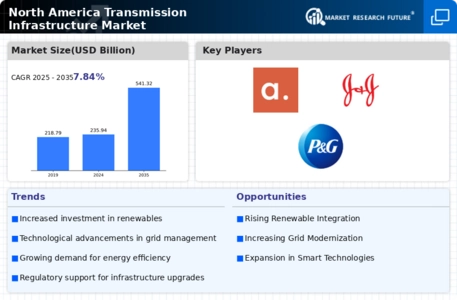Market Share
North America Transmission Infrastructure Market Share Analysis
In the ever-evolving landscape of North America's transmission infrastructure market, companies employ various strategies to position themselves favorably and capture market share. One prevalent approach is differentiation, where companies aim to distinguish their offerings from competitors through unique features or superior quality. This could involve developing innovative technologies that enhance efficiency, reliability, or environmental sustainability. For instance, companies might invest in advanced grid management systems or renewable energy integration solutions to stand out in a crowded market.
Another key strategy is cost leadership, which involves becoming the lowest-cost provider in the market segment. By optimizing operational processes, streamlining supply chains, and leveraging economies of scale, companies can offer competitive prices without sacrificing quality. This approach is particularly effective in price-sensitive segments of the market, where customers prioritize affordability over other factors. Additionally, cost leadership strategies can help companies penetrate new markets and gain market share by undercutting competitors on price.
Furthermore, market segmentation plays a crucial role in positioning strategies. Companies analyze the diverse needs and preferences of customers within the market and tailor their products or services accordingly. This allows companies to effectively target specific customer segments with offerings that meet their unique requirements. For example, companies may develop specialized transmission solutions for urban areas with high population density and complex infrastructure challenges, while also catering to rural regions with different needs and priorities.
Moreover, strategic partnerships and alliances are instrumental in expanding market reach and enhancing competitiveness. By collaborating with other companies, utilities, or government agencies, companies can access new markets, technologies, or resources that they wouldn't have access to otherwise. Strategic partnerships can also facilitate knowledge sharing and innovation, enabling companies to stay ahead of emerging trends and customer demands.
Additionally, branding and reputation management are essential components of market positioning strategies. Companies strive to build strong brands that resonate with customers and convey value, reliability, and trust. Positive brand associations can influence purchasing decisions and create a competitive advantage in the market. Companies invest in marketing campaigns, sponsorships, and corporate social responsibility initiatives to enhance their brand image and differentiate themselves from competitors.
Furthermore, customer-centric strategies focus on understanding and fulfilling the needs of customers to drive loyalty and retention. This involves gathering feedback, conducting market research, and continuously improving products or services based on customer insights. By prioritizing customer satisfaction and building long-term relationships, companies can gain a loyal customer base that serves as a foundation for sustainable growth and market share expansion.
The North America transmission infrastructure market is highly competitive, and companies employ various positioning strategies to differentiate themselves, capture market share, and drive growth. These strategies encompass differentiation, cost leadership, market segmentation, strategic partnerships, branding, reputation management, and customer-centricity. By effectively executing these strategies, companies can navigate the complexities of the market landscape and emerge as leaders in the transmission infrastructure industry.


















Leave a Comment